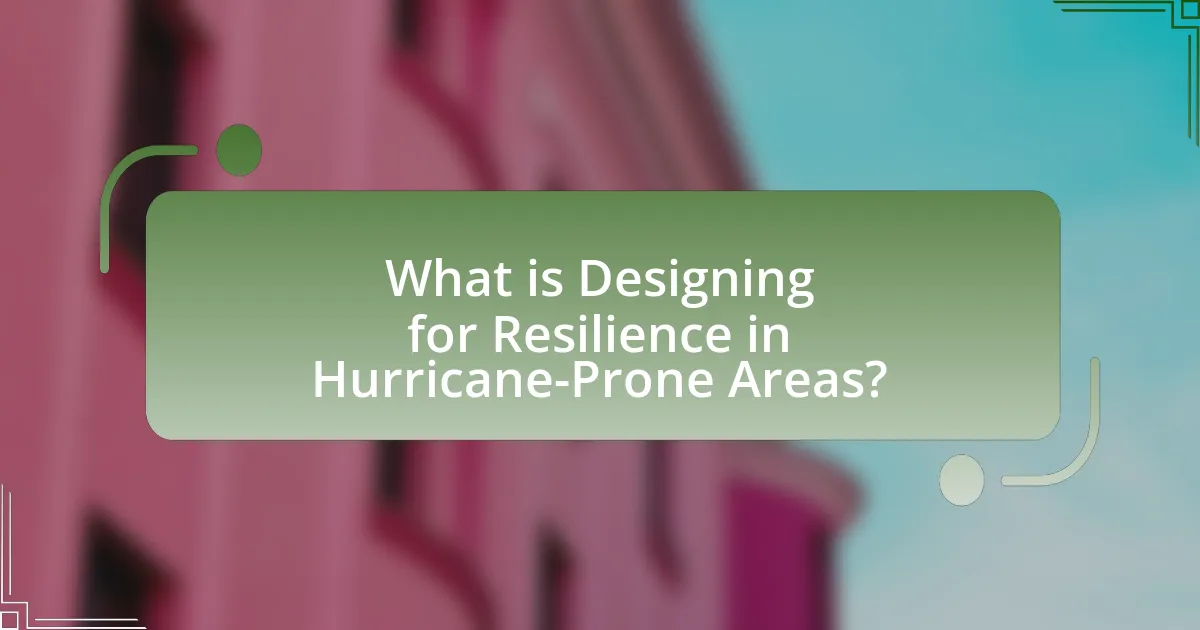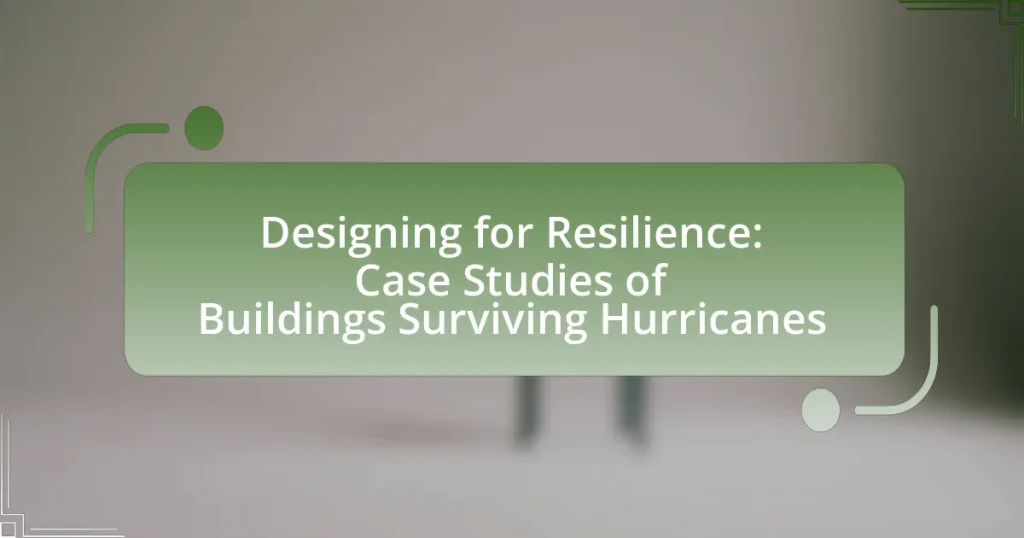The article focuses on designing for resilience in hurricane-prone areas, emphasizing the importance of creating structures that can withstand extreme weather conditions such as high winds, flooding, and storm surges. It outlines key principles of resilient building design, including adaptability, redundancy, robustness, and sustainability, while highlighting the impact of environmental factors on design choices. The article also examines notable case studies of buildings that have successfully survived hurricanes, detailing the innovative materials and technologies used in their construction. Additionally, it discusses the role of community involvement in resilient design planning and offers practical tips for homeowners to enhance their properties’ resilience against hurricanes.

What is Designing for Resilience in Hurricane-Prone Areas?
Designing for resilience in hurricane-prone areas involves creating structures that can withstand the extreme forces of hurricanes, including high winds, flooding, and storm surges. This approach incorporates specific architectural and engineering strategies, such as elevated foundations, reinforced materials, and aerodynamic shapes, to minimize damage during severe weather events. For instance, buildings designed with elevated platforms can reduce flood risk, while using impact-resistant windows can prevent wind and debris from breaching the structure. Research indicates that resilient design not only protects lives but also reduces economic losses; for example, the National Institute of Building Sciences estimates that every dollar invested in disaster mitigation can save society six dollars in recovery costs.
How does resilience in building design impact survival during hurricanes?
Resilience in building design significantly enhances survival during hurricanes by incorporating features that withstand extreme wind, flooding, and debris impact. Structures designed with reinforced materials, elevated foundations, and aerodynamic shapes can better resist the forces generated by hurricanes, reducing the likelihood of catastrophic failure. For instance, buildings constructed to meet or exceed the standards set by the International Building Code for hurricane-prone areas have shown a marked decrease in damage during storms, as evidenced by the performance of structures in Hurricane Andrew (1992) and Hurricane Katrina (2005). These resilient designs not only protect human life but also minimize economic losses by ensuring that buildings remain operational post-disaster.
What are the key principles of resilient building design?
The key principles of resilient building design include adaptability, redundancy, robustness, and sustainability. Adaptability allows structures to respond to changing environmental conditions, ensuring long-term functionality. Redundancy involves incorporating multiple systems or components that can take over if one fails, enhancing reliability. Robustness refers to the strength and durability of materials and design, enabling buildings to withstand extreme weather events, such as hurricanes. Sustainability focuses on using eco-friendly materials and energy-efficient systems, reducing the overall environmental impact. These principles are supported by case studies demonstrating that buildings designed with these concepts can effectively survive and recover from severe weather events, thus validating their importance in resilient architecture.
How do environmental factors influence design choices for resilience?
Environmental factors significantly influence design choices for resilience by dictating the materials, structural integrity, and layout of buildings to withstand extreme weather events. For instance, in hurricane-prone areas, architects often select aerodynamic shapes and elevate structures to reduce wind pressure and flooding risks. Research indicates that buildings designed with reinforced concrete and impact-resistant windows can better endure hurricane conditions, as evidenced by the success of structures in Hurricane Andrew, where resilient designs led to lower damage rates compared to traditional buildings. Thus, understanding local environmental conditions is crucial for making informed design decisions that enhance resilience against natural disasters.
Why is it important to study buildings that survive hurricanes?
Studying buildings that survive hurricanes is crucial for improving future architectural designs and enhancing community resilience. These structures provide valuable insights into effective construction techniques and materials that withstand extreme weather conditions, thereby reducing damage and loss of life during hurricanes. For instance, research has shown that buildings designed with reinforced concrete and aerodynamic shapes have significantly lower failure rates in hurricane-prone areas. Analyzing these successful examples allows engineers and architects to develop better building codes and standards, ultimately leading to safer environments for residents in vulnerable regions.
What lessons can be learned from successful case studies?
Successful case studies of buildings surviving hurricanes demonstrate the importance of robust design, materials selection, and community planning. These case studies reveal that structures designed with aerodynamic shapes and reinforced materials can withstand high winds and flying debris, as evidenced by the performance of buildings in Hurricane Andrew, where those adhering to strict building codes sustained less damage. Additionally, integrating elevated foundations and storm-resistant windows significantly reduces flood risk and water intrusion, as seen in post-Hurricane Katrina rebuilds. Furthermore, community-level preparedness and infrastructure resilience, such as effective drainage systems and emergency response plans, are critical for minimizing damage and ensuring safety during hurricanes.
How do these buildings contribute to community safety and recovery?
Buildings designed for resilience contribute to community safety and recovery by incorporating features that withstand extreme weather events, thereby minimizing damage and ensuring continuity of essential services. For instance, structures built with reinforced materials and elevated foundations can resist hurricane winds and flooding, reducing the risk of structural failure. Research indicates that resilient buildings can significantly decrease recovery time; for example, a study by the National Institute of Building Sciences found that resilient design can save communities up to $4 for every $1 invested in mitigation measures. This financial benefit underscores the importance of resilient buildings in enhancing community safety and facilitating quicker recovery after disasters.

What are Notable Case Studies of Resilient Buildings?
Notable case studies of resilient buildings include the New Orleans BioInnovation Center and the Treme Center, both designed to withstand hurricanes. The New Orleans BioInnovation Center, completed in 2016, features elevated structures and flood-resistant materials, demonstrating effective flood mitigation strategies. The Treme Center, built after Hurricane Katrina, incorporates storm-resistant design elements such as reinforced walls and elevated foundations, showcasing resilience in urban planning. These buildings exemplify how innovative design can enhance structural integrity and community safety in hurricane-prone areas.
Which buildings have successfully withstood hurricanes?
Buildings that have successfully withstood hurricanes include the San Juan Marriott Resort & Stellaris Casino in Puerto Rico and the University of Miami’s Student Center. The San Juan Marriott, built to withstand high winds and flooding, remained operational during Hurricane Maria in 2017, showcasing its resilience. Similarly, the University of Miami’s Student Center, designed with hurricane-resistant features, survived Hurricane Irma in 2017 without significant damage. These examples demonstrate effective architectural strategies for hurricane resilience.
What design features contributed to their resilience?
The design features that contributed to the resilience of buildings surviving hurricanes include aerodynamic shapes, elevated structures, and reinforced materials. Aerodynamic shapes reduce wind resistance, allowing the building to better withstand high winds. Elevated structures prevent flooding by raising the building above potential storm surge levels. Reinforced materials, such as impact-resistant windows and concrete walls, enhance structural integrity, enabling buildings to endure extreme weather conditions. These features collectively ensure that buildings can survive the intense forces associated with hurricanes, as evidenced by case studies of structures that remained intact during severe storms.
How did these buildings perform during specific hurricane events?
Buildings designed for resilience have shown varying performance during specific hurricane events. For instance, the New Orleans Superdome withstood Hurricane Katrina in 2005, serving as a shelter for thousands and sustaining minimal structural damage despite extreme winds and flooding. Similarly, the Miami-Dade County’s Hurricane-Resistant Building Code, implemented after Hurricane Andrew in 1992, has led to improved performance of structures, evidenced by the survival of many buildings during Hurricane Irma in 2017, which experienced winds exceeding 100 mph. These examples illustrate that resilient design significantly enhances a building’s ability to endure hurricane conditions, as demonstrated by their survival rates and functionality during and after such events.
What innovative materials and technologies were used in these buildings?
Innovative materials and technologies used in buildings designed for resilience against hurricanes include reinforced concrete, impact-resistant glass, and advanced weatherproofing systems. Reinforced concrete provides structural integrity and durability, allowing buildings to withstand high winds and flying debris. Impact-resistant glass minimizes the risk of shattering during storms, protecting occupants and maintaining building integrity. Advanced weatherproofing systems, such as air and water barriers, enhance energy efficiency and prevent water intrusion, further contributing to the building’s resilience. These materials and technologies have been proven effective in various case studies, demonstrating their capability to enhance safety and longevity in hurricane-prone areas.
How do these materials enhance structural integrity?
Materials enhance structural integrity by providing strength, durability, and resistance to environmental forces. For instance, reinforced concrete and steel framing are commonly used in hurricane-resistant designs due to their ability to withstand high winds and impact forces. Studies have shown that buildings constructed with these materials can endure wind speeds exceeding 150 mph, significantly reducing the risk of structural failure during hurricanes. Additionally, the use of advanced composites and engineered wood products can improve flexibility and energy absorption, further enhancing a building’s resilience against dynamic loads.
What role does technology play in monitoring and maintaining resilience?
Technology plays a crucial role in monitoring and maintaining resilience by providing real-time data and analytics that inform decision-making during extreme weather events. Advanced sensors and IoT devices are deployed in buildings to monitor structural integrity, environmental conditions, and potential hazards, allowing for timely interventions. For instance, the integration of Building Information Modeling (BIM) with real-time monitoring systems enables engineers to assess the performance of structures under stress, ensuring they can withstand hurricanes. Studies have shown that buildings equipped with such technology can reduce damage by up to 30% during severe storms, highlighting the effectiveness of technology in enhancing resilience.

How can Future Designs Improve Resilience Against Hurricanes?
Future designs can improve resilience against hurricanes by incorporating advanced materials, innovative structural engineering, and strategic site planning. For instance, using impact-resistant windows and reinforced concrete can significantly enhance a building’s ability to withstand high winds and flying debris, as demonstrated by structures in hurricane-prone areas that have successfully survived severe storms. Additionally, elevating buildings above flood levels and designing roofs to withstand uplift forces can further mitigate damage. Research shows that buildings designed with these features have a higher survival rate during hurricanes, as evidenced by the success of structures built to the latest building codes in Florida, which have shown reduced damage in recent hurricanes compared to older designs.
What emerging trends are shaping resilient building design?
Emerging trends shaping resilient building design include the integration of advanced materials, adaptive reuse of existing structures, and the incorporation of smart technology. Advanced materials, such as high-performance concrete and weather-resistant coatings, enhance durability against extreme weather events. Adaptive reuse focuses on modifying existing buildings to meet current resilience standards, reducing waste and preserving historical value. Smart technology, including sensors and automated systems, allows for real-time monitoring and management of building performance during adverse conditions. These trends are supported by research indicating that buildings designed with these elements can significantly reduce damage and recovery time after hurricanes, as evidenced by case studies of structures that successfully withstood severe storms.
How can architects incorporate climate change predictions into their designs?
Architects can incorporate climate change predictions into their designs by utilizing adaptive design strategies that enhance resilience against extreme weather events. These strategies include elevating structures to mitigate flooding, using materials that withstand higher temperatures and increased humidity, and designing for natural ventilation to reduce energy consumption. For instance, the National Oceanic and Atmospheric Administration (NOAA) reports that sea levels are projected to rise by up to 6.6 feet by 2100, prompting architects to elevate buildings in coastal areas to prevent flooding. Additionally, integrating green roofs and permeable surfaces can help manage stormwater runoff, aligning with predictions of increased rainfall intensity. By applying these methods, architects can create structures that not only withstand the impacts of climate change but also contribute to sustainable urban environments.
What role does community involvement play in resilient design planning?
Community involvement is crucial in resilient design planning as it ensures that the needs and preferences of local populations are integrated into the design process. Engaging community members allows for the identification of specific vulnerabilities and strengths within the community, leading to tailored solutions that enhance resilience against disasters, such as hurricanes. For instance, studies have shown that projects incorporating community feedback are more likely to succeed in mitigating risks and fostering a sense of ownership among residents, which is vital for long-term sustainability.
What best practices can be adopted for designing resilient buildings?
Best practices for designing resilient buildings include utilizing robust materials, implementing elevated structures, and incorporating flexible design features. Robust materials, such as reinforced concrete and impact-resistant glass, enhance durability against extreme weather conditions. Elevated structures, built above flood levels, reduce the risk of water damage during hurricanes. Flexible design features, like adjustable foundations and wind-resistant roofs, allow buildings to adapt to varying environmental stresses. These practices are supported by case studies, such as the University of Florida’s research on hurricane-resistant design, which emphasizes the effectiveness of these strategies in minimizing damage during severe weather events.
How can lessons from past hurricanes inform future designs?
Lessons from past hurricanes can inform future designs by highlighting the importance of resilient building materials and structural integrity. For instance, Hurricane Andrew in 1992 revealed vulnerabilities in conventional wood-frame construction, leading to the adoption of reinforced concrete and impact-resistant windows in new designs. Additionally, the aftermath of Hurricane Katrina in 2005 emphasized the need for elevated structures in flood-prone areas, resulting in updated building codes that require homes to be built above certain flood levels. These historical events provide concrete evidence that integrating lessons learned into design practices can significantly enhance the resilience of buildings against future hurricanes.
What are the common pitfalls to avoid in resilient building design?
Common pitfalls to avoid in resilient building design include inadequate site assessment, neglecting local climate conditions, and failing to incorporate redundancy in structural systems. Inadequate site assessment can lead to overlooking vulnerabilities such as flood zones or wind exposure, which are critical for buildings in hurricane-prone areas. Neglecting local climate conditions may result in designs that do not withstand specific weather patterns, such as heavy rainfall or high winds. Additionally, failing to incorporate redundancy in structural systems can compromise a building’s ability to withstand extreme events, as single points of failure can lead to catastrophic outcomes. These pitfalls have been highlighted in various studies, including the National Institute of Building Sciences’ “Natural Hazard Mitigation Saves” report, which emphasizes the importance of comprehensive planning and design strategies to enhance resilience.
What practical tips can homeowners implement for resilience?
Homeowners can implement several practical tips for resilience against hurricanes, including reinforcing roofs, installing impact-resistant windows, and elevating homes above flood levels. Reinforcing roofs with straps or clips can help secure the structure against high winds, as evidenced by studies showing that homes with these reinforcements sustain less damage during storms. Installing impact-resistant windows reduces the risk of breakage from flying debris, which is crucial since broken windows can lead to significant interior damage and increased pressure on the building envelope. Elevating homes above the base flood elevation minimizes the risk of flood damage, supported by FEMA guidelines that recommend this practice in flood-prone areas. These strategies collectively enhance a home’s ability to withstand hurricane conditions effectively.




